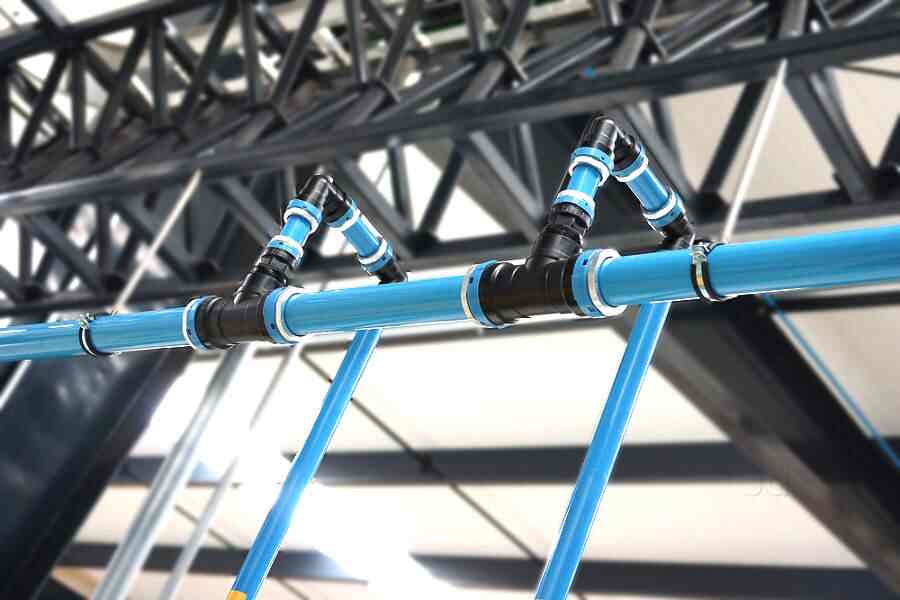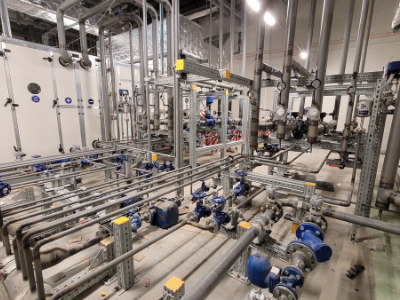Water in a compressed air system is a common problem that can occur for a variety of reasons. It can occur in places where pneumatic receivers are connected, as well as in installations made of aluminum tubes that are subject to large temperature fluctuations. Water can also be created by excessive air expansion during the operation of compressed air tools.
To remove water from a compressed air system, you must first accurately determine the causes of its occurrence. This may require a review of the type of installation, installation method, materials and components used to prepare the compressed air. It's also worth paying attention to weather conditions and the seasons when water is most common.
One solution to the problem is to use an adsorption dryer with a dew point of -35 °C. This type of dehumidifier is capable of effectively removing humidity from premises thanks to the use of special adsorbents that absorb moisture from the air. Another solution is to use a cyclone separator, which works on the principle of mechanical separation and allows water to be separated from air.

In addition to these solutions, there are also other ways to remove water from compressed air systems, such as using activated carbon filters or using special hydrophobic filters that can effectively remove moisture from the air. It is important to accurately diagnose the causes of water in the system.
Comparison of the effectiveness of different water removal methods from compressed air systems
Effectively removing water from your air system is important to ensure the proper functioning of your air tools and prevent damage to your system. There are many different methods for water removal, such as adsorption dryers, cyclone separators, activated carbon filters, and hydrophobic filters.
dryer
Adsorption dehumidifiers absorb moisture from the air using special adsorbents such as silica. They are most effective at low temperatures and low humidity, but their effectiveness decreases at higher temperatures and humidity. Adsorption dryers can be an effective solution for systems where temperature and humidity are constant or fluctuate slightly.
separator
Cyclone separators work on the principle of mechanical separation and separate heavier particles such as water from lighter particles such as air. Cyclonic separators are effective over a wide range of temperatures and humidity, but may be less effective when large amounts of water or other contaminants such as dust or steam are present.
If you are wondering which cyclone separator you should choose for your system, contact our experts. Our experts will help you choose the right separator tailored to your system needs.
filter
Activated carbon filters are capable of removing moisture from the air through adsorption on its surface. They are effective over a wide range of temperatures and humidity, but their effectiveness decreases over time as the activated charcoal loses its ability to absorb moisture.
Hydrophobic filters are special filters that can repel moisture from the air, preventing it from entering the system.
They are effective over a wide range of temperatures and humidity and their effectiveness does not diminish over time. Hydrophobic filters are lightweight, easy to use and require no maintenance, which is why they are often used in compressed air systems.
To choose the most suitable solution for removing water from compressed air systems, the causes of its occurrence must be carefully diagnosed and system conditions such as: B. temperature and humidity must be taken into account. It is also important to pay attention to the type of pneumatic tools used during installation and the possible presence of other contaminants, such as dust or vapors. It is also worth consulting experts and reading the opinions of other users to choose the most effective solution suited to specific needs and conditions.
How do you install and operate a cyclone dryer or separator in a compressed air system?
Presenting step-by-step instructions for installing and operating a cyclone dryer or separator in a compressed air system can be a useful addition to the article for readers who want to install this type of equipment in their system themselves.

Before beginning installation, ensure that the compressed air system is properly prepared and that its capacity and pressure meet the dryer or separator manufacturer's recommendations. Then prepare the appropriate tools and mounting elements such as bushings, screws and seals.
Installing a dehumidifier or separator
Step-by-step installation of a dryer or cyclone separator in a compressed air system could look like this:
- Find a suitable location to install the device. Cyclone dryers and separators are best installed in locations where temperature and humidity are constant or fluctuate slightly.
- Prepare the pipes leading to the dehumidifier or cyclone separator. Remember to ensure there is sufficient pipe slope and to use suitable fittings and seals.
- Install the dryer or cyclone separator according to the manufacturer's instructions.
- Connect the dryer or cyclone separator to the compressed air system using appropriate connections and seals.
- Check the tightness of the connections and the pressure in the system.
- Turn on the dehumidifier or cyclone separator and check that it is working properly.
Maintenance of cyclone dryers and separators in a compressed air system is generally simple and mainly involves regular inspection and maintenance of the equipment. Regularly check the water level in the tank and the cleanliness of the filter, if the device has one.
If you use a desiccant dehumidifier, it is important to change it regularly according to the manufacturer's instructions. This maintenance ensures the proper functioning of the dehumidifier and prevents water problems in the system.
If problems occur with the operation of the dryer or cyclone separator, inspect it for contamination or damage and ensure that the system pressure and capacity meet the manufacturer's recommendations. If necessary, contact the manufacturer or a professional for help troubleshooting the problem. Remember that proper care and maintenance of your dehumidifier and cyclone separator will help you avoid future water problems.
In summary, removing water from your air system is important to ensure the proper functioning of your air tools and prevent damage to your system.
How to prevent water from appearing in the compressed air system – tips and tricks
Including prevention and maintenance tips for your compressed air system to prevent water from occurring in the future can be a useful addition to the article for readers who want to keep their system working properly and avoid water-related problems in the future.
Here are some tips for prevention and maintenance of compressed air systems:
- Make sure your compressed air is treated regularly. Water in a compressed air system often occurs due to improper air treatment. Therefore, it is worth installing a dryer or cyclone separator or other compressed air preparation device to prevent the appearance of water.
- Install in places where temperature and humidity are constant or fluctuate slightly. Water in a compressed air system is often caused by fluctuations in temperature and humidity. Therefore, it is worth avoiding installation in places where these parameters are very different, such as: B. close to doors or windows.
- Ensure regular maintenance and replacement of installation components. Water in a compressed air system often appears due to damage or contamination of installation elements. Therefore, it is worth regularly checking the condition of pipes, fittings and other installation elements and replacing them if they are worn or damaged.
- Pay attention to the proper slope and position of the installation pipes. Water in a compressed air system often occurs because the pipes are not routed correctly, which results in water remaining in the system. Therefore, it is important to ensure that the installation pipes have a suitable slope and are placed in such a way that water can drain without obstacles.
- Ensure regular maintenance and cleaning of dryers and cyclone separators. Water in a compressed air system often occurs as a result of contamination or damage to cyclone dryers and separators. Therefore, it is worth regularly checking the condition of these devices and cleaning and maintaining them in accordance with the manufacturer's instructions.
Prevention and maintenance of your compressed air system are essential to avoid water leaks in the future.
Regular air treatment, adequate management of the installation, regular maintenance of installation components and adequate maintenance of dryers and cyclone separators prevent the occurrence of water in the compressed air installation. However, remember that the appearance of water in the system cannot always be avoided, despite the preventive measures taken. Therefore, it is worth being prepared for such a situation and having suitable tools and equipment for removing water, such as dehumidifiers or cyclone separators.

























































